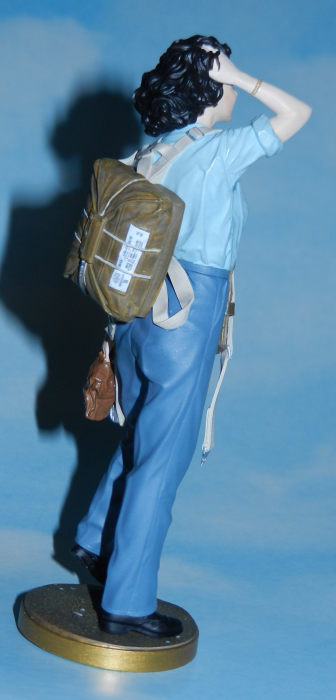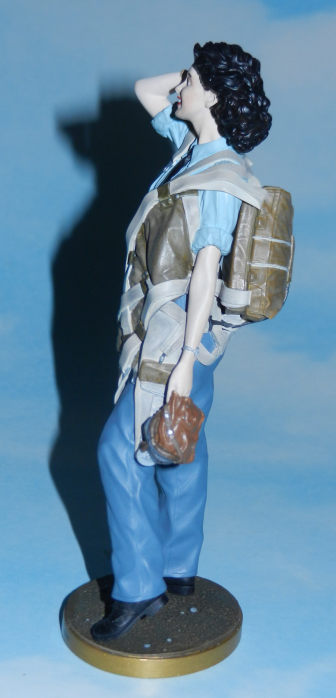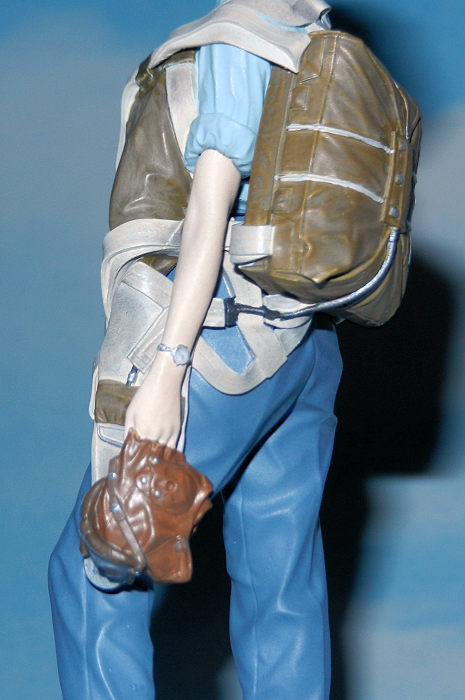
Life Miniatures 1/? Maureen Dunlop
| KIT #: | 16005 |
| PRICE: | $65.00 |
| DECALS: | None supplied |
| REVIEWER: | Pablo Calcaterra |
| NOTES: | Resin |

| HISTORY |
Maureen Adele Chase Dunlop was born in 1920 in Quilmes, Buenos Aires Provine, a city on the south side of Buenos Aires City (now know at the Great Buenos Aires). Her father was Australian and her mother was British. Her father fought in World War I and afterwards managed a vast expense of farmland owned by a British Company (around 620,000 acres or 250,000 hectares of sheep farms) in the Argentine Patagoinia. The couple had two other kids, Joan who was older than Maureen and Eric who was younger.
Having initially been raised by a governess, Maureen briefly attended St Hilda’s College in Hurlingham, Buenos Aires Province. The environment in which she grew clearly influenced her later years. In the farms she became an expert horse rider and would gallop alongside the trains and wave at the conductors. When she was 16 years old she went on vacation to Great Britain and she started to take flying lessons. Upon her return to Argentina she forged her birth certificate to back date it and be old enough to take flying lessons at the Aeroclub Argentino.
When the war started in 1939 she decided to participate in the conflict. Her sister also travelled to the UK and joined the BBC.
For a female pilot to be part of the ATA (Air Transport Auxiliary) they had to mass 500 flying hours, twice as much as their male counterparts. Only in April 1942 she was able to accumulate the needed hours.
She was originally attached to No6 Ferry Pool at RAF Ratcliffe but then Maureen was transferred to the Pool based at Hamble, Southampton which was commanded by Margot Gore. The fact that they were near Southampton meant that they were delivering Spitfires from the Supermarine factory to the different RAF Squadrons. During her time with the ATA she flew 38 types of different planes and added another 800 flying hours. She flew, Spitfires, Mustangs, Hurricanes, Typhoons, Barracudas, Lancasters, Mosquitoes (her favourite type), Wellingtons…
 Her time
delivering planes was not without incident and once she had to do an emergency
landing after the canopy of her Spitfire blew off shortly after take off. On a
different one the engine of her Fairchild Argus quit (it was vibrating badly and
it turned out one of the pistons had cracked) and forced her to land in a field.
After the ensuing investigation she was cleared of any fault.
Her time
delivering planes was not without incident and once she had to do an emergency
landing after the canopy of her Spitfire blew off shortly after take off. On a
different one the engine of her Fairchild Argus quit (it was vibrating badly and
it turned out one of the pistons had cracked) and forced her to land in a field.
After the ensuing investigation she was cleared of any fault.
There were 164 enlisted in the ATA and in 1943 they succeeded in changing the regulations to receive the same pay as men of equal rank in the ATA. This was a first time the British Government approved the same salary for both men and women under their control. This movement was led by Conservative MP (later Dame) Irene Ward. Ten of her fellow female pilots lost their lives serving with ATA.
Dunlop would have loved to enter combat but females were not allowed. She considered unfair that only men would be killed in action. They were also discriminated by their male counterparts, forbidden to cross the Channel and even called by the males in the RAF “The Lestbian’s Pool” when they were based in Hamble. Female pilots were NOT trained to fly on instruments so when the weather was bad they were not allowed to fly. And even if they tried they were facing a potential reprimand.
One day and after landing a Fairey Barracuda she was talking to others on the ground when she realized that someone was shooting pictures of her. To her amazement she became the front cover of the September 16, 1944 issue of Post Magazine (Vol 24, No 12).
By war’s end she had reached the rank of First Officer, the equivalent of Flight Lieutenant in the RAF.
After the war most of her colleagues did not succeed to secure a job as a pilot. On the other hand, Dunlop was certified as an Instructor at RAF Luton in England, worked as such for a brief period of time and then returned to Argentina where she flew for the Argentine Air Force and taught its pilots, flew commercially and even trained pilots of Aerolineas Argentinas. She was also partner in a aero taxi company and flew actively until 1969. Her love for Arabian horses derived in buying a farm to breed them. It was called Milla Lauquen Stud.
 During a party at the British Embassy in Buenos Aires in 1955 she met a
former Romanian diplomat called Servian Popp. They got married and had 2
daughters and a son. In 1973 they travelled to England where they bought a farm
near Norwich. Here, using her ample expertise in horses they continued with her
passion for breeding Arabian horses. Her inexhaustible energy and love for her
horses meant that while working with younger men employees these would get tired
before she would.
During a party at the British Embassy in Buenos Aires in 1955 she met a
former Romanian diplomat called Servian Popp. They got married and had 2
daughters and a son. In 1973 they travelled to England where they bought a farm
near Norwich. Here, using her ample expertise in horses they continued with her
passion for breeding Arabian horses. Her inexhaustible energy and love for her
horses meant that while working with younger men employees these would get tired
before she would.
Funnily enough her Second World War car driver license had expired and she was forced to take a test to obtain a new one. It took her 5 tries until she succeeded. In 2003 Maureen Dunlop de Popp was one of the three ATA female pilots to receive the Guild Of Air Pilots and Air Navigator’s Master Air Pilot Award. She passed away peacefully at her home on May 29, 2012 at age 91.
| THE KIT |
Sculpted by Sang-Eon Lee this resin kit is one of the best resin ones I have ever worked with. The small boxy is very sturdy and there’s enough foam inside to protect the delicate parts.
Resin is of high quality, quite dark grey, no bubbles at all on the surface and designed in a way that the pieces are built up/locked onto each other for the model to gain strength as parts are attached.There is no painting guide nor instructions and that’s the only fault that I can think of.
| CONSTRUCTION |
Prior to building, all the parts were removed from the casting blocks and then painted. See below for detailed information on painting. Without instructions it was a bit challenging to build and I almost made the fatal mistake of adding the parachute almost as the first step.
Sequence was as follows: shoes to pants, head to torso, right arm to head and torso, legs to torso, wide parachute part with quick release to front of left leg, parachute to torso, strap on left shoulder, two strapps coming down the front of the parachute towards the legs, left arm, right foot to base.
| COLORS & MARKINGS |
 After
removing all the casting gates I washed the parts with soap and water. A coat of
Vallejo light grey acrylic was applied. With the airbrush I started to apply the
main colours:
After
removing all the casting gates I washed the parts with soap and water. A coat of
Vallejo light grey acrylic was applied. With the airbrush I started to apply the
main colours:
Shirt: Vallejo 70.907, Pants: FS35164 from ModelMaster 4744, Skin: light base FS12001 ModelMaster 4601 followed by a very diluted coat of Warm Skin FS12003 ModelMaster 4603 only on those areas that are more exposed to the sun (i.e. this was not applied to the internal side of the arms or under the chin).
The other main parts were painted with a brush and were as follows: Helmet in brown FS30117 ModelMaster 4707, Parachute bag Field Drab FS30118 ModelMaster 4708 and then drybrushed with Khaki FS30277 Vallejo 70.988. The loops were painted with the same Field Drab darkened with a drop of black. Parachute straps were painted with Sand FS33531 ModelMaster 4720. The base was painted Dark Earth (Vallejo 71029) and drybrushed with green Vallejo 70.893). Shoes were painted black with the sole drybrushed in Dark Earth.
Going onto the details of the face: teeth and white of the eyes were
painted gloss white, an extremely diluted black wash was applied to highlight
the teeth, lips in red, brown was used as a base of the hair which then was
followed by a light coat of black. Skin colour pastels were sanded and applied
with a Q tip to give the skin on the face a bit more of variance. The pupils
were painted dark brown. Of note is some makeup potentiall y
visible in the image of the cover of Post. I did some research and one of the
popular colours used for the eyelids in the 1940s was brown. I purchased a brown
pastel, sanded and applied the dust with a microbrush. A bit of make up was
added to the cheeks with red pastels using the same technique. The face of the
watch was painted gloss white and the rest of it in Chrome. The bracelet was
painted Gold.
y
visible in the image of the cover of Post. I did some research and one of the
popular colours used for the eyelids in the 1940s was brown. I purchased a brown
pastel, sanded and applied the dust with a microbrush. A bit of make up was
added to the cheeks with red pastels using the same technique. The face of the
watch was painted gloss white and the rest of it in Chrome. The bracelet was
painted Gold.
Parachute harness metal connecting parts were painted in Aluminum. Moving back to the helmet: after applying the base brown colour, the googles were carefully painted in a darker shade (mixing a bit of black), the metal frames using a dark grey (FS36099 Vallejo 70.867). The clear parts were painted with Future. All metallic details were picked out using Chrome. Perspiration under her right armpit as seen on the cover of the magazine was done mixing a bit of black with the basic shirt colour. The tie was painted Black. The bungee cords in the parachute pack were painted Sand.
The base was hand painted in Brass with some “stones” being picked out using a light grey. Then all the surfaces that required it were dirtied using Dry pastels sanded dust applied with Q tips: parachute straps, parachute bag, her buttocks and knees, a bit here and there on the shirt…
To go beyond the original kit, I made my own decals: found a very clear image of an almost brand new Irvin parachute. Reduced it to scale, printed on white decal paper, cut into 3 parts (avoiding the bungee cords), and then covered it with a brush applied coat of Matt varnish. The quick release arrow and text for the parachute came from another image found on line and printed in clear decal paper. The face of the watch (less than 2mm diameter to scale!) came from a picture of her own watch shot during the Post visit to the base. It shows 1.30 pm! It was then covered with a drop of Future.
Finally a decal that reads “Maureen Dunlop – ATA – 1944” was made on clear decal paper, added to the front of the base and protected with Future.
| CONCLUSIONS |
A truly amazing figure to honor an equally amazing female pilot. Fit is excellent and no putty was required at all.
Dedicated to Maureen Dunlop de Popp and all her ATA colleagues that delivered more than 500,000 planes during the war.
| REFERENCES |
Wikipedia
Eastern Daily Express
Aircrewremembered
9 August 2024
Copyright ModelingMadness.com.
All rights reserved. No reproduction in part or in whole without express
permission from the editor. If you would like your product reviewed fairly and fairly quickly, please
contact the editor
or see other details in the
Note to
Contributors. Back to the Main Page
Back to the Review
Index Page
Back to the Previews Index Page